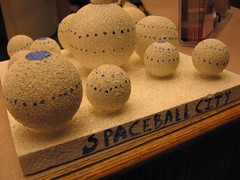Presenter: Michael Porter, WebJunction
Hi-fi is usually associated with audio equipment, but fidelity is very much related to our work: interoperability, compatibility, quality of the document, etc.
When you distill what libraries are and what they do, it comes down to content and community, and this is what libraries will still be in the future. Star Trek’s LCARS stands for Library Computer Access and Retrieval System — even those folks thought that the “library” would be that integrated into everything in the future.
The line between hardware and software is blurring now, particularly with software that can emulate hardware. Costs for technology are decreasing, computing power is increasing, and battery life is getting longer. There are newer and better methods of creating content, and competition for content provision is getting fierce. And, you can find community all over the Internet.
The Google Android phone is actually just software that is open source and can be used by any wireless phone manufacturer, and can be hacked by any coders who want to enhance the functionality. The Bug is hardware that comes in components that can be hooked together to created whatever you need, like a digital camera or portable computer.
Audio test for the video section – Rickroll!
The Time Machine: Computer interface in the library is represented as a human hologram. Also, the reference interview was… a bit rude. Books were represented as being behind preserved glass, and the students carried hand-held pads to download content.
Star Trek IV: Human-computer interaction in the Star Trek future uses voice recognition, but in 1985, that wasn’t possible.
Star Trek IV: Spock is working with three monitors, each presenting different problems. He uses a mixture of voice and tactile inputs to respond.
Futurama: 1000 years in the future, we will still have books and the Dewey Decimal System.
I, Robot: “ban the Internet to keep the libraries open”
Futurama: Will be able to get physical things from the Internet. We already have printers that can print in 3-D!
How William Shatner Changed the World: TNG wanted us to get the notion that we should not be afraid of technology.
Minority Report: Manipulates computer visuals using hi-tech gloves.
How William Shatner Changed the World: Modern-day physicist uses his knowledge to examine the realistic possibilities of Star Trek.
Zardoz: Ring that projects data.
Futurama: Librarians hold the keys to power, but it doesn’t always appear that way.

